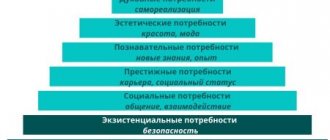Updated July 23, 2021 330 Author: Dmitry Petrov
Hello, dear readers of the KtoNaNovenkogo.ru blog. Creativity has become a fashion statement.
This concept is used as a personal characteristic, people are proud of it and justify any actions, and it is also an item in many resumes.
There is a strong belief that today we cannot do without it, but knowledge here is limited to the vague “something related to creativity.”
Let's find out what creativity is and how to use this word correctly so as not to make a mistake.
What is creativity?
Let's figure out what a creative person means. Creativity is a special personal quality that allows you to effectively engage in creative, creative, innovative activities.
Creative people are those who are able to find new and optimal ways to solve problems. They can see a problem from different angles, sometimes seeing it in a way that no one has seen before. However, creativity is not only innovation and creativity, it is a constructive way of thinking that brings practical benefits in various activities.
Example 1
For example, Air Canada executives noted that their logo—a bright red maple leaf inside a red circle with a white background—didn't do much to flatter Canadian pilots who remained loyal to their government. For them, this logo was too strongly associated with bureaucracy.
Air Canada funded a comprehensive study and the end result of the survey was that Canadians have many home values. Management decided to focus on these qualities in their logo and soften the government association. For the new logo, they designed an earthy-toned maple leaf with an evergreen tail.
What is the difference between creativity and creativity?
Very often people confuse these concepts or use them as synonyms, without thinking about the true meanings of the words. Creativity is also the ability to create new things. However, the concept of creativity refers to art and aesthetic creation, and creativity refers to the area of utilitarian, practical application. These two properties of the human personality can intersect, but do not have to be combined and do not stem from one another.
Modern professions, especially those related to innovation, require creativity - the ability, based on accumulated experience and knowledge, to generate new ideas and methods that optimize the work process or create a unique product. The concept of creativity includes such qualities as determination, the ability to take risks, intelligence, resourcefulness, and quickness of thought. Also, creativity is always accompanied by a broad outlook, because without one, it is difficult to come up with a new solution to a problem.
Where did this concept come from?
Many different studies have always been conducted to test IQ; there are many different tests and techniques in this regard, and the results are measured in points.
And it would seem that those who have the highest level of intelligence have the highest chance of achieving success in life.
However, it is not.
Thanks to research, it has been revealed that success in life, solving complex problems, finding new ideas, is weakly related to high intelligence, that is, a high IQ does not guarantee success.
It also happened in life that people who had a high level of intelligence did not always achieve success, but people with a lower level of intelligence achieved much greater success.
It was then that researchers created such a concept as creativity.
Let me give you one example.
One day, an incident occurred that clearly demonstrates the power of creative thinking.
A ketchup company decided to increase its revenue. The standard solution in such a situation was to increase advertising costs, which, according to analysts, would lead to an increase in profitability by 4-5%. This is quite a bit and such growth was far from the tasks that the company faced.
The board of directors, as they say, began brainstorming, they were looking for solutions, but could not come up with anything new.
However, one engineer proposed a seemingly simple, but essentially ingenious solution.
His suggestion was to simply increase the size of the opening on the bottle.
The logic was simple: the larger the outlet, the more ketchup people will waste, the faster the ketchup will run out, and the person will go to the store to buy a new one.
This solution did not require an increase in advertising costs, but by applying it in practice, they received an increase in revenue of up to 40%.
This is one of the examples of a creative approach, when we move away from standard and template options and find something that is simple and ingenious at the same time.
Professions for creative people
Creative thinking is needed in many fields, including business, advertising, science, art and politics. Nowadays, in many job offers you can find a message that the employer is looking for creative people for various positions.
Creativity in business is the ability to adapt to new management styles and change in accordance with changing market conditions. Business, especially small or medium-sized ones, does not tolerate conservatism. Nowadays, the development of business technologies is proceeding very quickly, new advanced training courses, new trends in personnel management, and so on are constantly appearing. Creativity in business is needed for mobility, speed of decision-making and innovation.
Creativity in advertising is the ability to present a product in a new way, from an unexpected angle. In the modern world, a person receives an overwhelming amount of information per day. Advertising specialists no longer know how to attract the attention of a potential consumer without causing irritation in an overly intrusive or flashy way. It is to solve such problems that creative people are needed in advertising. The advertising message must be of high quality, interesting and informative.
Creativity in the service sector is the ability to find new approaches in communicating with people. This area of application of creativity requires not only a good knowledge of people in the everyday sense and developed intuition, but also an accumulated store of knowledge in the field of psychology and sociology. For the sales sector, it is important to be able to present a product in such a way that a potential buyer wants to purchase it; in the hotel business, the design of rooms or, for example, features of guest service can be creative.
Creativity will find a place in almost any profession if it is subordinated to purely utilitarian goals and not confused with creativity. Most often, creative people are those who, in addition to a developed imagination, have knowledge in the field of economics, management, production technology, and so on.
Creative in the professional sphere
Highly valued in many professions, creativity has considerable practical significance. Photographer, marketer, designer, event organizer, SMM manager - the list of specialties that require creative individuals can be continued for a long time.
There are calculations showing that in the near future up to 60% of professions will become unclaimed - people will be replaced by robots. Only those areas where creative thinking is required cannot be replaced by artificial intelligence.
The staff of advertising agencies, design studios and other similar places often has a “profile” position - creative director. He leads art groups, generates ideas, and is responsible for the final creative product.
Creativity has become a “stamp” on the resumes of a variety of professions, from general director to manager. What do employers mean by this quality, and how to avoid mistakes when filling out this column?
- The main thing is not to overdo it, relying only on creativity. Practice shows that most employers view this quality with a grain of salt. For example, a brand manager is, first of all, a person who masters brand promotion technologies, and only then a creative person.
- A statement about the ability to think outside the box must be supported by real creative achievements (as an option, use a self-invented slogan or logo as an example).
- It is preferable to decipher the concept indicating specific skills and abilities. “I can develop an unconventional product positioning strategy” - this phrase will convince a potential employer that he has a good employee in front of him and should hire him.
Not every position requires creativity from the person filling it. A creative accountant will most likely not please the employer.
Ways to develop creativity
What does the word creative person mean? Creativity is not an innate ability. Yes, there must be prerequisites for it, but it can and should be developed. There are various methods for developing creativity in children and adults. In childhood, attention is paid more to the development of creative abilities and skills, on the basis of which, in combination with acquired experience and knowledge, creativity can subsequently be developed.
Let's look at several exercises to develop this ability.
- Discussing an idea in a team where everyone has a specific role: critic, dreamer and realist. Considering a problem from three points of view allows you to see its new facets and solutions.
- Creating a tree of associations. A problem is depicted on a piece of paper, with lines running from it where ideas related to it are written. In the process of creating a tree, ideas may arise that would not immediately come to mind.
- Take the opposite route. Imagine what needs to be done to ensure that the problem is not solved, and then replace these ideas with the opposite ones.
- It is recommended to expand your horizons - to be interested in everything that happens around you. Go to theatres, visit exhibitions, read newspapers, journalism and communicate more often with creative people, they have something to tell.
This is not a complete list of exercises for developing creativity, but they are all related to expanding the horizons of thinking, developing imagination and destroying stereotypes.
Part 3. What books to read
I'll be brief here. The Internet is full of reviews and reviews of these books. Some I have already read and are actively implementing techniques from there, others are waiting for their turn.
Vasily Lebedev. CRAFT Michael Micalko. Rice Assault Michael Micalko. Hacking creativity Edward de Bono. Genius Heinrich Altshuller. Find an idea by Mark Levy. Genius to order Dave Gray. Liminal Thinking Julia Cameron. The Artist's Path Gareth Moore. Lateral logic
Read books, practice techniques and use them to create creative solutions.
I hope this article has lifted the veil of secrecy over the concept of “creative thinking”. In my Telegram channel I write about training, development of cognitive functions and working with information. I will be glad to see all interested people.
The most creative people
With the growing interest in the term “creativity” in the last decade, printed publications related to this concept began to appear. Many countries publish their own magazines about creativity. Editors of publishing houses compile lists of the most creative people of the past year. These include owners and founders of advertising agencies, software developers, directors, designers, writers, entrepreneurs, singers and journalists.
According to Creativity magazine, the most creative person is Sachin Agarwal, founder of the website Posterous. Along with him, his colleague Jerry Tan was also named the most creative person.
planning
Planning consists of the following goals.
- Completing the organization's mission.
- Completion of organizational goals.
- Assessing organizational behavior and strategies relative to competitors.
- Conducting an effective SWOT (strengths, weaknesses, opportunities and threats) analysis.
Completing the organization's mission.
Completion of organizational goals.
Assessing organizational behavior and strategies relative to competitors.
Conducting an effective SWOT (strengths, weaknesses, opportunities and threats) analysis.
Signs of a creative person
And yet, what does a creative person mean? Like all internal human qualities, creativity has an external manifestation in behavior.
By what signs can such a person be distinguished from the crowd?
- Creative people are brave people. They are not afraid to try new things.
- Intuition is no less important a decision-making tool for them than logic.
- Creative people have a great sense of humor.
- Creative people are those who share their thoughts and ideas with others.
- They easily understand the most intricate interweaving of information. Creative people subject the information received to critical reflection and never follow the crowd's lead.
- They are interested in the process itself, and not just the result.
- They love to learn new things and look for answers to the most difficult questions. The more difficult the task, the more willingly a creative, creative person will take on it.
- Creative people are always in search of: solutions, answers, knowledge and ideas.
- Creative people are excellent teachers. They easily explain things that are difficult to understand to others, trace connections between existing material and create new things from it.
- A creative person does not tolerate boundaries or boundaries. He constantly expands his horizons, tries on new points of view.
- Creative people are innovators. They are interested in testing new ideas and find themselves competitive in the future.
Searching for unknown paths
A person is creative - this is when he, without listening to the opinions of others, searches for unexpected, sometimes shocking discoveries, while offering a lot of options - from reasonable to more fantastic. He is always full of ideas, he has a lot of interesting thoughts in stock, and he is always ready to share them with others, because in the next minute his irrepressible imagination will prepare a dozen more similar discoveries. Moreover, these will not be crude, hastily invented solutions, but a solid concept, taking into account all the pros and cons and a forecast of future events.
Fashion for creativity
Currently, every second resume in the “additional information” column indicates a quality – creativity. What is a creative person? Is it so important to be creative? Yes, many specialties require making innovative decisions, the ability to think outside the box and present oneself or a product in a non-trivial way. But at the same time, there are enough specialties that do not require a creative approach. In everyday life, the meaning of this feature is even more blurred. With the fashion for creativity, many people want to appear creative and inventive even when communicating with their friends.
A non-creative person is not a person without imagination, unable to think beyond stereotyped constructions. Creativity is, rather, an integral quality for some areas of professional activity, rather than vitally necessary in everyday life. A person does not have to be creative, but it is useful to develop creative abilities at any age.
leading
The leader consists of the following goals.
- Increase productivity in the workplace.
- Providing better training for people to improve their performance.
- Be a good listener and offer good alternative approaches to roadblocks.
Increase productivity in the workplace.
Providing better training for people to improve their performance.
Be a good listener and offer good alternative approaches to roadblocks.
What is the creative class and does it exist in Russia?
The creative class in Europe and America is usually called people who design and create new ideas, images, and products. These are designers, advertising specialists, marketers, and so on. The global task of the so-called creative class is to change the world, make it more convenient and adapt it to the needs of the population. In a less global sense - to give an attractive appearance to products, introduce any innovations related to everyday comfort, add functionality to household items and equipment. In Russia there is no creative class as such. Here these people are in the minority, since society currently needs creative developments less than European or American ones. This is due to the peculiarities of culture and mentality. However, we can say for sure that the creative direction of activity in Russia is developing. New niches are being found and created in the service market where creative specialists are required. It is difficult to predict whether Russia will catch up with Europe in this sense, but there is no doubt that the creative class will develop in Russia as well.
Case Study: From Steam to Gasoline Cars
The steam engine was initially considered a failed invention; it was too bulky and made it very difficult to manage. The first coal engine or the first gasoline steam engines were also not considered successes, as they created such a large noise distraction on public roads that the police banned their further use.
It was Edward Butler
who created what many would call a "futuristic model" of a gasoline-powered tricycle, with a two-cylinder engine, carburetor and spark plug ignition, produced by a dynamo in 1884.
These were the days of Red Flag laws;
driving any such vehicle could have serious consequences if its speed increased from 4 miles per hour on roads to two miles per hour in built-up areas.
The name "Red Flags" comes from the strict laws made when using any such form of commutation where the owner of any such vehicle must hire another person to walk in front of the vehicle with red flags and warn people of the approaching vehicle which was still good for the owners of these cars, since earlier laws imposed death sentences for such inventions.
It was creative problem solving that made these gentlemen realize their dreams and bring their inventions to life, even in the face of dire consequences. These creative thinkers can be considered the fathers of the modern lifestyle of the 21st century.
Efforts to establish a link between intelligence and creative problem solving have been made many times, but after years of research, psychologists have concluded that creativity is not the same as intelligence. Someone can be much more creative than smart, or vice versa, without any influence on the other parameter.
With productive thinking, the goal is to create different approaches and consider even the least obvious or likely approaches. Creative problem solving creates a desire to continue searching for different approaches even when a promising solution to a problem has been found.
Rigid thinking tends to lead to an inability to solve problems because such problem-solving methods rely on past experience to be successful. Such problem-solving methods are thus called reproductive thinking.
The main reason highly productive creative thinkers produce so many rich, varied, and divergent ideas is because they are looking for a new perspective that no one else has considered. Therefore, the first step of creative problem solving is to re-visualize the problem in many unique ways. The first few ways of looking at a problem may be too reproductive to offer unique solutions.
With each different level of restructuring, understanding of the problem improves, leading the thinker to the root of the problem. At this stage, the creative thinker abandons all reproductive thinking steps that stem from their past experiences and reframes the problem. Another noted ability of creative thinkers is that they manage to operate between ambiguous opinions and incompatible subjects.
What is creativity for?
This quality is used in various fields to solve different problems. In general, creativity is needed to optimize, improve, increase efficiency, increase functionality and production capacity. In a word – for a qualitative leap forward. In science and production, creativity is needed to invent new equipment, new technology, even production technologies themselves. Creativity makes our life more interesting, colorful and comfortable. The transition from an industrial society to a post-industrial one was marked by the expansion of the service sector. Currently, the ability to present a service or product to a potential consumer plays an important role in this area.
Beauty, energy and novelty combined with practical use - this is the creativity that, in practical application, gives aesthetic pleasure and everyday comfort.
Organization
The organization consists of the following pointers.
- Define roles and responsibilities in the organization.
- Grouping different but complementary jobs in an organization.
- Deciding on the level of authority and permission that will be given to various designations.
Define roles and responsibilities in the organization.
Grouping different but complementary jobs in an organization.
Deciding on the level of authority and permission that will be given to various designations.
example
Edison's first invention of the light bulb, which is the earliest lighting system, involved connecting wiring in parallel circuits to the high-resistance incandescent filaments in his lamps. The idea of using parallel circuits and resistance wires were two opposing ideas that did not occur to ordinary thinkers of the time, but Edison could see the connection between the two incompatible things.
Creative people themselves do not know how creative they are. It is for others to discover and use. Viewers can identify a creative person by the way these people lead their lives.
People who exhibit creative behavior have a unique set of qualities, some of which are listed below −
- Challenging the status quo
- Avoid Assumptions
- Naturally curious
- Always explore all possibilities
- Have a vivid imagination
- Think about the future
- Don't believe in the final idea
- Never think it's impossible
- How to take risks
- Can adapt to changing circumstances
- Can connect seemingly disparate events
- Visual thinkers
- Templates can be defined
- Look beyond the first "right idea"
Successful problem solving
As with any process that involves imagination, creative problem solving also faces two major obstacles: individual
and
organizational
. Many organizations develop their vision for the future by looking to the past for experience. Through this approach, they draw their plans for situations and scenarios they have already encountered. This does not necessarily prepare them for the challenges of tomorrow, since they have already lost the ability to anticipate.
It is this blocking of ideas
inhibits the growth of creative problem solving. It is the presence of these blocks that makes the process of creative problem solving difficult to put into practice without the initial environment provided for it.
Successful problem solving consists of three stages of creative problem solving
—
Task Environment Recognition
The first step of creative problem solving involves perceiving the events surrounding the problem, then interpreting the events and understanding the nature of the task in which the person must engage in order to achieve a solution.
Sympathy with the problem
At this stage, people need to be specific about the goal. They must complete what needs to be done regarding the goal and what actions will contribute to achieving the goal. There must be a transparent approach to the roots of the problem, without any premature conclusions.
Processing of available information
This is the most important step because real creative problem solving is used in problem solving, here in practice. The information available, along with the problem solver's information processing style, makes a big difference here.
Creative problem solving has led to the development of learning applications that focus on personal feedback and guidance. Many strategic blocks can be addressed through creative problem solving techniques when it comes to value creation. Values, however, are a more complex issue, but creating an understanding of personal values in an individual offers some respite.
Mental blocks for creativity can be strategic, value-oriented, perceptive
and
self-confident
blocks. The real idea should be to facilitate the process of producing ideas. Because of these methods, new ideas and ideas will be formed. Free thinking techniques are used as a guiding sense to evoke, construct and reconstruct the knowledge stored in our memory.
Organizing group sessions where people brainstorm ideas reduces the risk of making mistakes as individuals. These sessions will also help reduce personal biases. By telling people about the problem or hearing our ideas, we will be able to understand people's reactions and suggestions.
Touch Gating
Touch logic
is a process the brain uses to adapt to stimuli.
Our brains are directly involved in filtering out distracting stimuli and performance. Negative emotions such as stress, anxiety and depression can change brain chemistry and limit the effectiveness of sensory gating. Thus, to prevent this imbalance, it is important to reconsider the gate
.
Creativity is not an entity that you can command at will. It is very dependent on the environment and can only be induced with appropriate stimulation and with the appropriate collaborators. Thus, the myth that creativity can be induced as per demand is bogus. This must depend on proper care and encouragement from management.
Strategic blocks
The inability to provide insight or think through unfeasible ideas indicates blocked thinking. Often people themselves admit that they are in a block. However, this block is subconscious. People with creative disorders often exhibit negative thinking and attitudes towards their work and life in general.
Value blocks
The biggest challenge to creative problem solving occurs when people tend to mistake outdated business practices for values. Often creative problem-solving training programs face opposition from line managers who claim they have always done things a certain way.
These methods that have given them results are trusted by them, so they believe that they should not deviate from these methods. These people are afraid of change and do not want to take risks. Naturally, they will be in the know when it comes to new scenarios in the future.
Self-confidence block
Sometimes low levels of self-confidence create fear in people's minds and make them hesitant to make any changes and solve problems creatively. Their reluctance to make decisions out of the box is because they are afraid of failure or laughter.
Barriers to innovative ideas
Many people are accustomed to traditional ideas, and this is often one of the main obstacles to creative problem solving. Because of this thought, people and organizations tend to fall into various traps when trying to become more innovative. Here are some of the most common problems that people face when trying to solve any problem using traditional methods:
- They focus on non-problems.
- Finishing one idea too quickly.
- Often rework an unfinished idea.
- They cannot convey their ideas to management.
- They are afraid to change or challenge any established methods.
Some of the other basic blocks are described below.
Management control
Managerial control tends to stifle creativity. Creative thinkers should be given as much autonomy and freedom as possible in their work environment.
Short-Range Thinking
Creative problem solving should be used to find long-term solutions and benefits for the company, not to ultimately develop policies for short-term gain.
Analysis Paralysis
Through the constant analysis and polishing of ideas, the creative process gets lost in the process, often because each polish of a creative idea brings it closer to the established process.
Rigid hierarchical relationship
Strict command lines are not an appropriate way to communicate for creative people. When they come across an idea, they like to know its feasibility. The tendency to seek big returns must be curbed.
Marketing vs. Technology Product Planning
Many people tend to overemphasize market research. The idea should be to focus more on marketing orientation, but this should not come at the expense of good ideas that come from R&D and never take off.
Pressure to achieve more with few resources
Research and development departments are often distinguished by cost-cutting methods. They like to save as much as possible so they can ask management less. However, the ideal creative environment should be as free as possible from pressure to do better with fewer resources.
Example: how Swiss watches lost their market
The Elgin Watch Company is often used as an example of companies that have not taken the cure for their market myopia. They fell on their way from becoming one of the biggest names in the watch business to closing up shop for good. The company lived in denial of changing market demands and risked losing customers for its most widely known product, the superior-lifetime pocket watch.
English watchmakers were the pioneers of watchmaking in the early eighteenth and nineteenth centuries. They were responsible for all the latest technological breakthroughs; however, their biggest problem was that they did not keep up with the times, which put them out of competition with other major Swiss and American watch manufacturers who had a better understanding of their customers' needs.
Today, it may seem quite obvious to us that in order to survive in the market, a company must adapt its strategy to meet the changing needs and demands of its customers. However, the watch industry has a few quirks and doesn't always respond as one might expect. The unexpected does not always lead to complete failure.
The Swiss watch industry dominated global markets with its fine watch movements, elegant designs and quality in the 20th century. Until that time, the value of a watch depended on its accuracy and how long it had been kept. High quality Swiss watches had an "Officially Certified Chronometer" certificate issued by the Swiss authorities, making their price far out of reach of the average person. Apart from precision, features like self-winding, elegant design, metallic gold case and other things have been used to add to its appeal.
However, a scientific breakthrough came and the technology of quartz movement was discovered. This allowed all watch manufacturers to mass produce these precision watches. Although this technology was invented by the Swiss, they did not implement it for fear of collapse in their own market. However, other companies gradually caught up and the Swiss watch market lost 25% of its market share.











